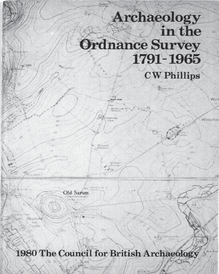CBA Occasional Papers
Council for British Archaeology, 2000. (updated 2013) https://doi.org/10.5284/1000333. How to cite using this DOI
Data copyright © Council for British Archaeology unless otherwise stated
This work is licensed under the ADS Terms of Use and Access.
Primary contact
Council for British Archaeology
92 Micklegate
York
YO1 6JX
UK
Tel: 01904 671417
Resource identifiers
- ADS Collection: 284
- DOI:https://doi.org/10.5284/1000333
- How to cite using this DOI
Archaeology in the Ordnance Survey 1791-1965
C W Phillips
CBA Occasional Papers No. 11 (1980)
ISBN 0 900312 90 4
Abstract

Today, and for more than a century past, the standard map series published by the Ordnance Survey have carried detail of as many ancient sites and features as the scale of the map and the current state of knowledge has permitted. This has not only been acceptable as adding interest to the maps, but it has also been an important influence in promoting the study of archaeology in the British Isles.
The Survey was founded in 1791 but no serious attempt was made to put this part of its practice on a sound basis before 1830, and then only in Ireland. The work of the Survey is ultimately defined and governed by the Ordnance Act of 1840, and this does not contain any statutory obligation beyond showing antiquities with all the other detail when their physical importance or long-established fame requires it. But in spite of this fact the product of nearly two hundred years' work has been a delineation of the archaeology of the British Isles on our maps which still has no parallel for completeness in any other major national survey in the world.
The relative smallness of the British Isles and the long period in which they have had a complete and effective map coverage have played their part in securing this, one of the Survey's direct contributions to the national culture. Rooted in the best 18th century practice represented by the work of Major-General William Roy, the Survey's true progenitor, it has been maintained and extended by the interest of a distinguished succession of officers who have declined to take a narrow view of the objectives of the Survey. As a result the shade of an earlier Britain haunts every Survey map and has contributed to the rise of an informed public interest in the country's archaeology and history. There is little information available today about the early development of this activity. For all but the period since 1920 there are only three main sources of information: an examination of practice as shown by the actual content of pre-1920 maps and plans, the Survey records relating to Ireland still preserved in Dublin, and references by Sir Charles Close, Brigadier Winterbotham, and a few others in their publications, all of which are based on materials largely destroyed in 1940 (Close 1926; Winterbotham 1934, 85-8). The practice of supplying antiquities began as part of what was normally expected, in some degree, of those who made maps in Britain; in the Survey it gradually became fully established custom before 1920 and in this process there was much improvisation joined with a large use of the amateur rather than the professional approach.
Contents
- Title pages
- Foreword by Prof W F Grimes (pp v-vii)
- Introduction (p 1)
- William Roy, a pioneer field archaeologist (pp 2-4)
- Archaeology on the Old Series 1in maps (pp 4-6)
- Colt Hoare and the 1in survey in Wiltshire (pp 6-10)
- The Irish 6in survey of 1824-46 (pp 10-14)
- The Templemore Memoir (pp 14-16)
- The large-scale survey of Great Britain 1854-94 (pp 16-22)
- The revision problem 1894-1920 (pp 22-23)
- The Crawford period 1920-45 (pp 23-29)
- The advent of air photography (pp 29-30)
- The period maps (pp 30-39)
- The international 1/1,000,000 scale map of the Roman Empire (p 39-40)
- The development of the Archaeology Branch (pp 40-42)
- The disaster of 1940 (pp 42-44)
- The Ordnance Survey moves to Chessington (p 44)
- The post-war programme (p 45)
- The archaeological outlook in 1947 (pp 45-47)
- The revival of the Archaeology Branch (pp 48-51)
- Early activities in the field (pp 51-52)
- The problem of access to libraries (pp 52-53)
- The record system (pp 53-55)
- The Assistant Archaeology Officers and devolution in Scotland (pp 55-57)
- Conclusion (pp 57-60)
- Postscript: December 1979 (pp 61-62)
- Appendix: Archaeological and historical maps published by the Ordnance Survey 1870-1978 (p 63)
- Bibliography (p 64)
Download report
| Archaeology in the Ordnance Survey 1791-1965 (CBA Occassional Papers 11) | 1 Mb |







